Homemade Farmer's Cheese - Whether you refer to it as farmer cheese or cottage cheese, making this recipe is both simple and cost-effective.
Follow the steps, and you'll have scrumptious homemade cheese ready for your cherished recipes.
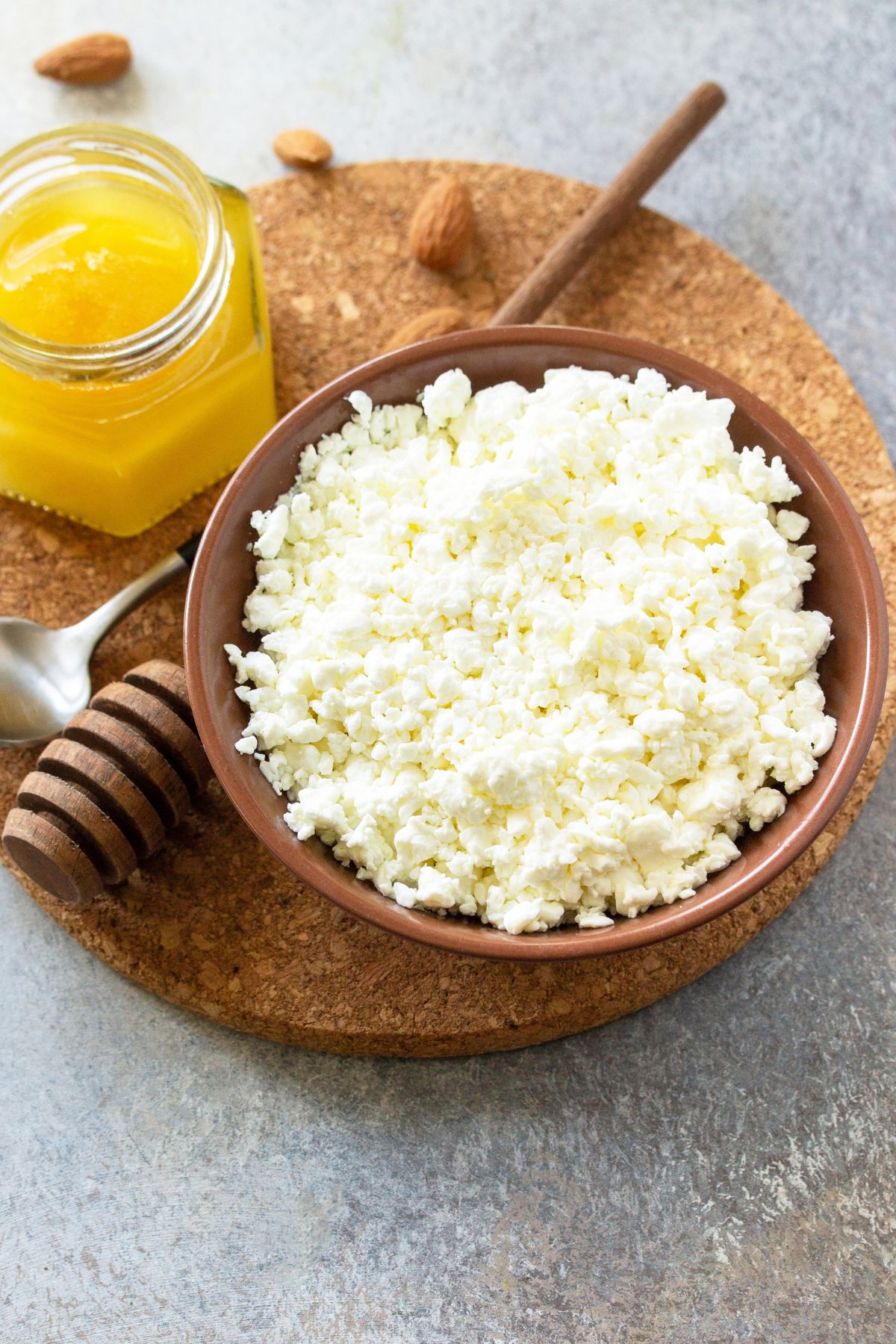
The only ingredients you need are good-quality milk and some vinegar or lemon juice.
What is Farmer's Cheese
Farmers cheese, also known as "farmer cheese" or "dry curd cheese," is a simple, fresh cheese that's similar to cottage cheese, but it's pressed to remove most of the moisture. This results in a crumbly, soft cheese that's versatile for cooking or eating on its own.
Traditionally, raw milk is allowed to clabber(or curdle) for 24 - 48 hours until it becomes pleasantly sour and has the consistency of yogurt. Then, the milk is warmed up slowly, on low heat, until it reaches a temperature between 100 and 110°F (38 - 43°C).
As the milk gets warmer, curds begin to separate from the whey and form the farmer's cheese. Once the curds are separated, they are removed from the pot and allowed to drain through a cheesecloth.
I grew up with many delicious recipes that make good use of the farmer's cheese. From appetizers to desserts, these recipes were easy to make and used basic ingredients that people had in their pantries.
Sometimes it is not easy to find this cheese in the stores. Therefore, I make it at home from scratch. It is such an easy recipe to make, and the cheese can be used right away.
Like most things homemade, this cheese is tasty, creamier, and healthier than any farmer's cheese you find at the grocery store. I call it farmer cheese, but in some parts of the country, you will probably find it under the name of cottage cheese.
Note: What you need to know is that farmer's cheese or cottage cheese is not ricotta cheese. Ricotta has a smaller curd with a drier texture, and it is produced differently.
Many of you asked me what farmer cheese is or where you can find it. I decided that it would be a good idea to share a simple recipe with you. As we do not have access to raw milk, what do we do?
We will use milk from the store. The recipe is so simple that I am embarrassed to call it a recipe. The only ingredients we will need are whole milk and some vinegar or lemon juice. Also, a cheesecloth to strain the cheese.
How To Make Farmer's Cheese At Home
There are two different types of cottage cheese, one is a small curd cheese that is made by adding some sort of an acid to the whole milk, usually vinegar or lemon juice. Sometimes yogurt, cream, or buttermilk is added to the milk.
The other type is a large-curd cheese that is made by adding Rennet to the milk, an enzyme that helps milk curdle and creates bigger cheese curds, like the cottage cheese you buy in the store, and it is a little bit salty.
We are going to make today the small curd cheese, which is very easy to make at home and does not require any fancy equipment.
What Will You Need
- 1-gallon whole milk
- ¼ cup white vinegar(or lemon juice)
- Cheesecloth
- Strainer
- Saucepan- about 4 quarts
- Thermometer
Note: I do not recommend using ultra-pasteurized milk for cheesemaking because the curd will not set.
Ultra-pasteurized milk is not always labeled as such, but you can tell because the expiration date is very long.
Regular pasteurized milk, however, works fine for cheesemaking. From 1 gallon of whole milk, you should obtain about 2 cups of farmer cheese.
Also, you can use any kind of milk you like, 2%, 1%, etc. However, when you use whole milk, you will get a bigger yield of cheese, and the texture will be creamier.
Conclusion: You will get a lot more farmer cheese from a gallon of whole milk than you will from a gallon of skim milk.
This being said, let's make the cheese.
Step 1. In a large pot, heat the milk to about 185-190F/85-87C. Use a thermometer if you have one. Otherwise, the milk should be heated close to the boiling point.
Remove it from the heat and add the vinegar or the lemon juice. Stir the milk slowly in a circular motion.
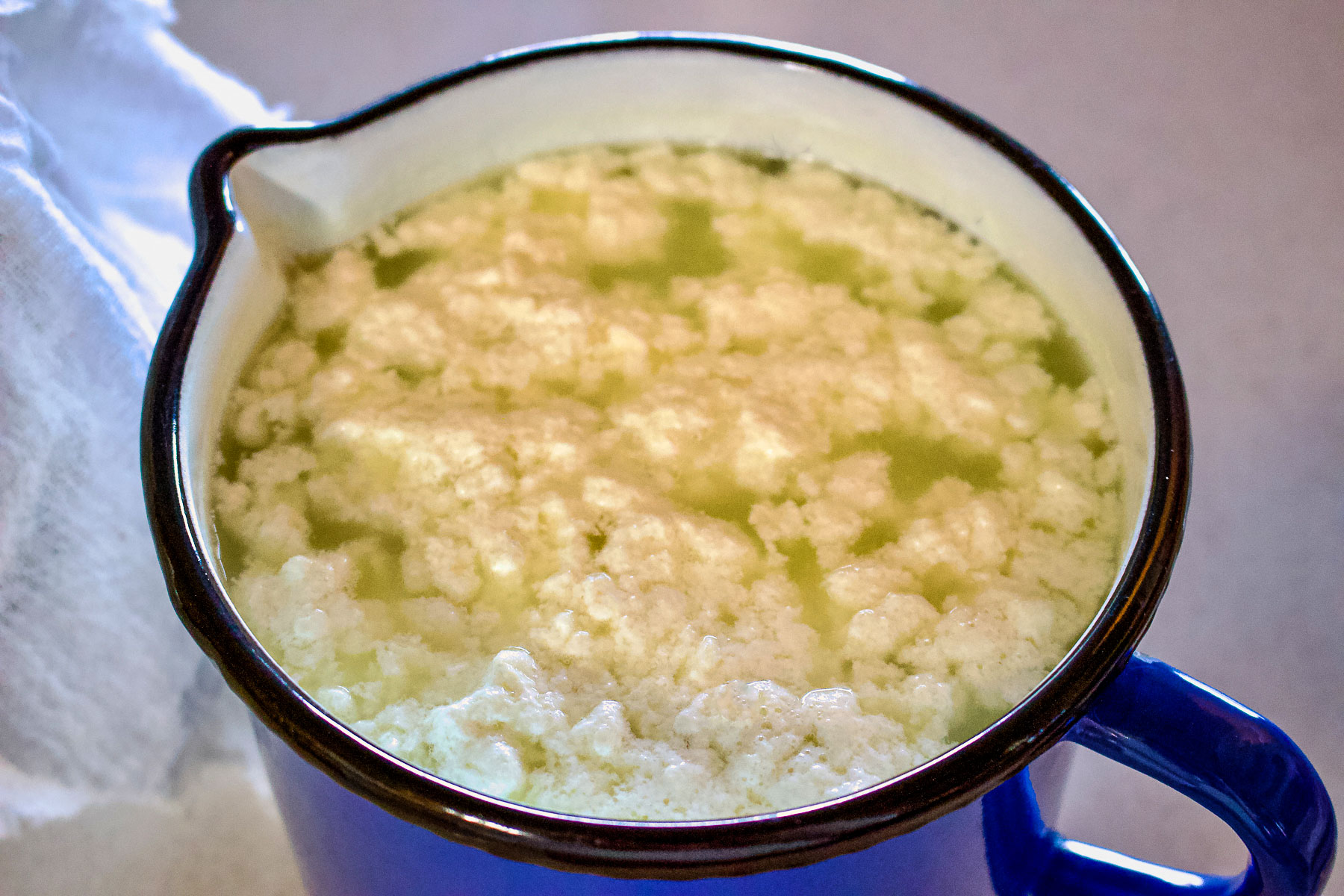
If the milk has already started to cool and the curds still did not separate from the whey, return it back on the stove and reheat for another few minutes.
That should do the trick. Put a cheesecloth over a strainer and set it over a large mixing bowl. Scoop out the curds with a slotted spoon and transfer them to the cheesecloth.
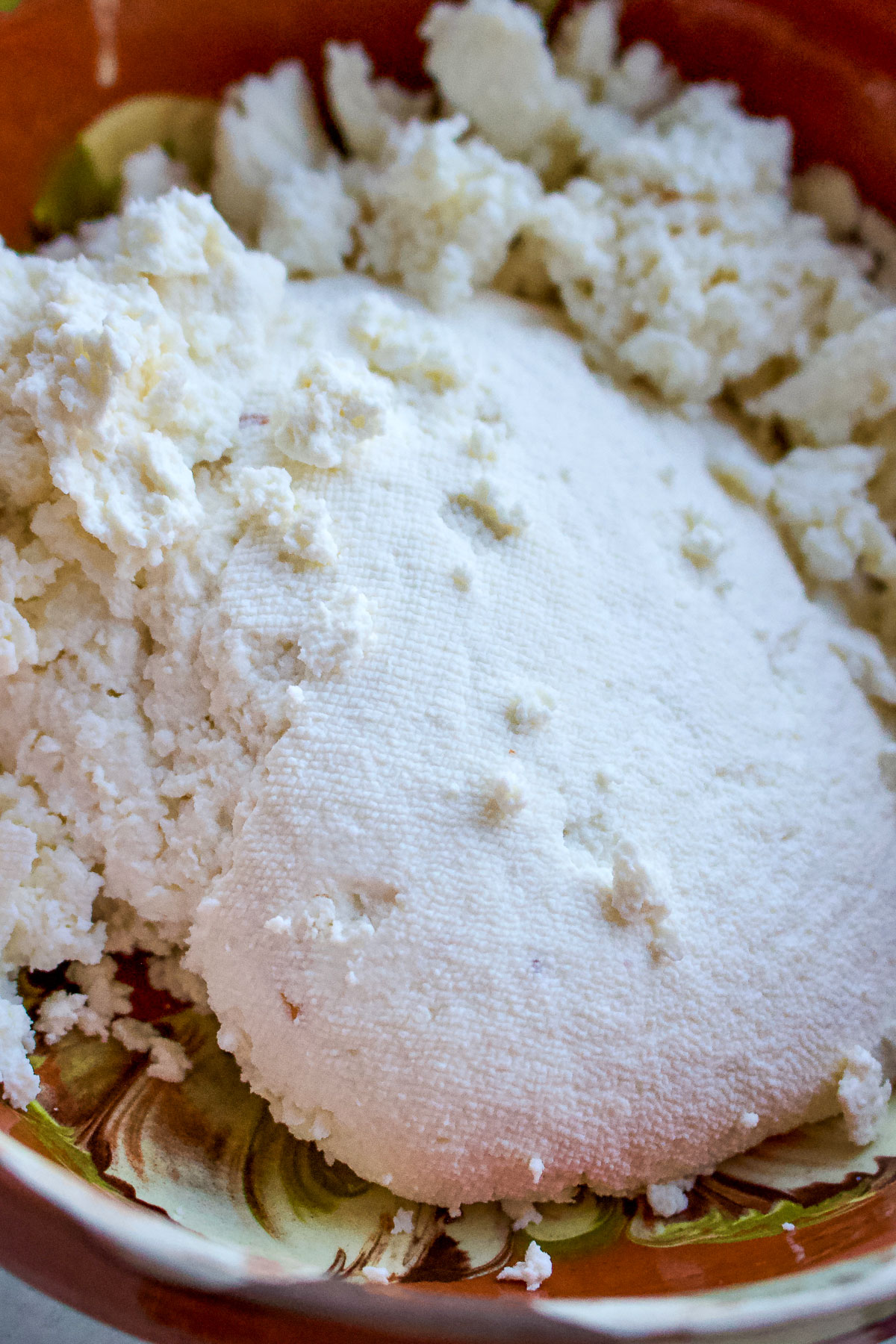
Tie the cheesecloth up using the corners and weigh it down to drain. Move it to the refrigerator for a few hours or overnight. When ready, remove the cheesecloth and add a little bit of salt to your taste. The cheese is ready to be used for your favorite recipes.
Expert tip:
Do not throw away the whey! You can use it to make a delicious whey bread with it. It is really easy.
Just replace the water for the dough with whey. Whey has lots of nutrients and is especially rich in proteins, so you get a wonderful benefit if you use it in the bread.
Use Of Farmer's Cheese In recipes:
I make pastries with it, like this Romanian Farmer Cheese Sweet Pastries that are popular on the blog. There is a reason for that: they are absolutely delicious! Or you can try these Sweet Cheese Pastries. Besides pastries, I make cakes and bars with Farmer's cheese. Take a look at this Meringue Farmer Cheese Cake . Or these delicious cookies, where the dough is actually made with farmer's cheese.

What are your favorite ways to use farmer cheese? Feel free to share it with us in the comments.
📖 Recipe

Farmer's Cheese Recipe
Equipment
Ingredients
- 1 gallon whole milk
- ¼ cup white vinegar or lemon juice
Instructions
- In a large pot, heat the milk to about 185-190F/85-87C. Use a thermometer if you have, otherwise, the milk should be heated close to the boiling point.
- Remove it from the heat and add the vinegar or the lemon juice.
- Stir the milk slowly in a circular motion.
- If the milk has already started to cool and the curds still did not separate from the whey, return it back on the stove and reheat for another few minutes. That should do the trick.
- Put a cheesecloth or a tea towel over a strainer and set it over a large mixing bowl. Scoop out the curds with a slotted spoon and transfer them to the cheesecloth.
- Tie the cheesecloth up using the corners and weigh it down to drain.
- Move it to the refrigerator for a few hours or overnight.
- Remove the cheesecloth and add a little bit of salt to your taste.
- The cheese is ready to be used for your favorite recipes.
- Do not throw away the whey! You can use it to make a delicious whey bread with it. (see article)
Notes
- I do not recommend using ultra-pasteurized milk for cheesemaking because the curd will not set. Ultra-pasteurized milk is not always labeled as such, but you can tell because the expiration date is very long. Regular pasteurized milk, however, works fine for cheesemaking.
- You can use any kind of milk you like, 2%, 1% etc. However, when you use whole milk, you will get a bigger yield of cheese and the texture will be creamier. You will get a lot more farmer cheese from a gallon of whole milk than you will from a gallon of skim milk.


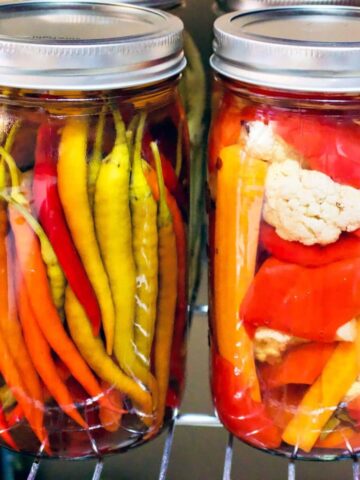
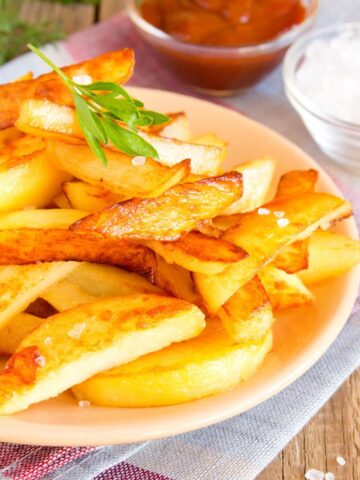
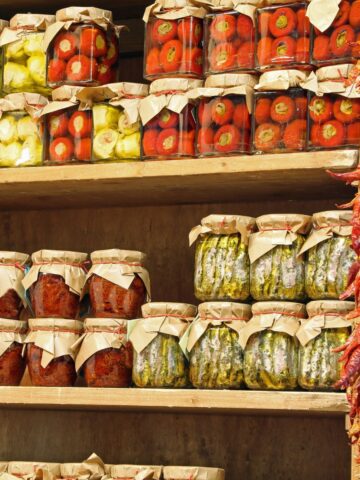
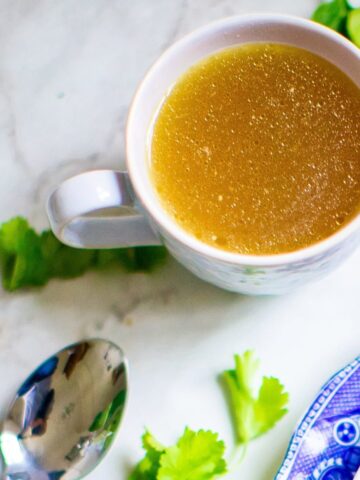
Joanne Schultz says
Hello..... I just attempted my first batch of Farmers Cheese using only 1/2 G of whole milk. I'm pretty sure it was not Ultra pasteurized, but after I took it off the stove and stirred in about 1/8 c. of lemon, it started to form curds, but maybe only 1/4 cup of it. Shouldn't it make about 1 cup with 1/2 Gal of milk??
The Bossy Kitchen says
Hi Joanne, Did you have a lot of leftover whey or it looked still like milk? Sometimes you need to increase the amount of lemon/vinegar in order to obtain more cheese. Also, the milk is so different from one brand to another that this might happen once in a while.
Joanne Schultz says
thanks for your reply, but I did have a whole pot of the milk leftover... so, my main question is Do I skim off the curds that have formed and put into cheesecloth and then heat the milk up again , but add more lemon or vinegar? And do you use only 1 layer of cheesecloth?
The Bossy Kitchen says
Yes, you can skim the curds that have formed and return the pot to the stove. Add some more lemon or vinegar. I would also add maybe 2 layers of cheesecloth, so you can catch as much curd as possible.
Joanne Schultz says
Hello again..... I want to make the Whey milk sprouted spelt bread you suggested. How long can I keep the leftover whey in the frig since making the Farmers Cheese a couple days ago? thanks
The Bossy Kitchen says
I would say, you should use it this week sometime. If you don't think you will get to it soon, freeze and use it when you have more time for bread.
Mello Wolf says
How long will this last in the fridge? I have plans to use it this weekend but made it last Thursday (one week already).
The Bossy Kitchen says
I would say, use it as soon as possible. Before that, taste it and see if it is still good.
Joseph says
going to try making this with Goat Milk. and press some into a block
Carol Yonov says
I have always wanted to try making farmer cheese but wonder how long it lasts? At Pascha (Easter) we make a traditional sweet cheese dessert - it is made from the cheese, butter, powdered sugar, and eggs. It is all put through a food mill at least twice, then into a mold to drain for a couple days. We use at least 2# of cheese and 1# butter (down from when we used 5# cheese!). It makes alot to gift to friends.
There are also cookie recipes I make which use the cheese as a filling and then baked. Again, how long does it last in such a baked cookie?
Thanks for any info.
The Bossy Kitchen says
Hi Carol, this is a quick recipe for Farmer cheese made at home. I do not specialize in making cheese, but because I did not have access to fresh cheese in the US sometimes, I like to use this old recipe when I need cheese for a particular recipe. As far as I know, any fresh cheese should be kept in the refrigerator. If appropriately stored in an airtight container, it will last about a week. If you want to make cookies with this cheese, I would not keep them on the counter for more than two days. If you're going to keep them longer, you either refrigerate or freeze them.
Kathy Fuller says
I have been making farmers/cottage/"ricotta" cheese at home for years, and I'm not even a very good cook. Never had it fail. So simple even I have it mastered. I'm at a loss when I read the comments. About the only possible problems are using ultra pasturized milk or not getting the milk hot enough (190 - 200 deg), or possibly letting it go past boiling point. I don't use skim milk so that may affect results. I don't bother with skimming rinsing, squeezing, or hanging in a cheesecloth. I just add the white vinegar, stir a bit, and after 5 min or so dump in a tea towel lined strainer over a large bowl. Drain a few min then pick up the towel and dump the cheese into another bowl. When cool I pack and freeze till I'm ready to make lasagna because this make perfectly acceptable "ricotta". It freezes just fine for many months.
You'd have to make an awful lot of this to get enough whey to come up with more than a few spoon fulls of real recooked ricotta. Without the final addition of cream you have what is essentially the same thing as ricotta.
Now as to all that leftover whey in the bowl. After spending all that time making healthy hommade cheese it would be foolish to toss out all the nutrition left in the whey. I freeze it in 1 cup portions, I just use ziploc baggies. Then I grab a frozen baggie anytime I need something using 1c. or more of water like pancakes, rice, instant mashed potatoes, a pot of soup, even a box dinner like Hamburger Helper or Rice a Roni. No worries on how long to store in fridge, freezes just fine for months.
Since milk was only 1.98/gal this week I'm about to spend a half hour or so today preserving it as cheese and whey. seriously it's easier than pie.
Elisa says
I just made this with a 1/2 gallon of 1% milk. I had to return to the heat and add more lemon juice several times but I ended up with about 1-1/2 cups of farmer cheese. I make that no knead bread every day so tomorrow's bread I will make with the whey water (which is actually still quite cloudy and now looks like skim milk.